Abstract
Richardson, Marvis (Michigan State University, East Lansing) and Jane N. Holt. Synergistic action of streptomycin with other antibiotics on intracellular Brucella abortus in vitro. J. Bacteriol. 84:638–646. 1962.—It has been found that streptomycin acts synergistically with penicillin and tetracycline to inhibit the growth of Brucella abortus within bovine cells cultured in vitro. Extracellular penicillin at 10 to 50 μg/ml was essentially bacteriostatic for intracellular brucellae. A combination of 5 to 50 μg/ml of streptomycin, which alone did not prevent the multiplication of intracellular brucellae, and 50 μg/ml of penicillin was bactericidal. Tetracycline at 0.5 to 1.0 μg/ml, which permitted growth or was bacteriostatic for brucellae within tissue cells, proved markedly bactericidal when combined with 10 μg/ml of streptomycin. Within certain limits, the synergistic effect of streptomycin and tetracycline did not appear to be a function of concentration. When the addition of streptomycin was delayed until 24 hr after the addition of tetracycline, the antibiotics acted synergistically on intracellular brucellae. To achieve intracellular synergism, five to ten times the effective extracellular concentration of streptomycin was required. Penicillin and tetracycline acted at the same concentration on extracellular and intracellular brucellae. These results suggest that tissue cell systems may prove useful for study of multiple drug therapy to be used in vivo against intracellular bacteria.
Full text
PDF


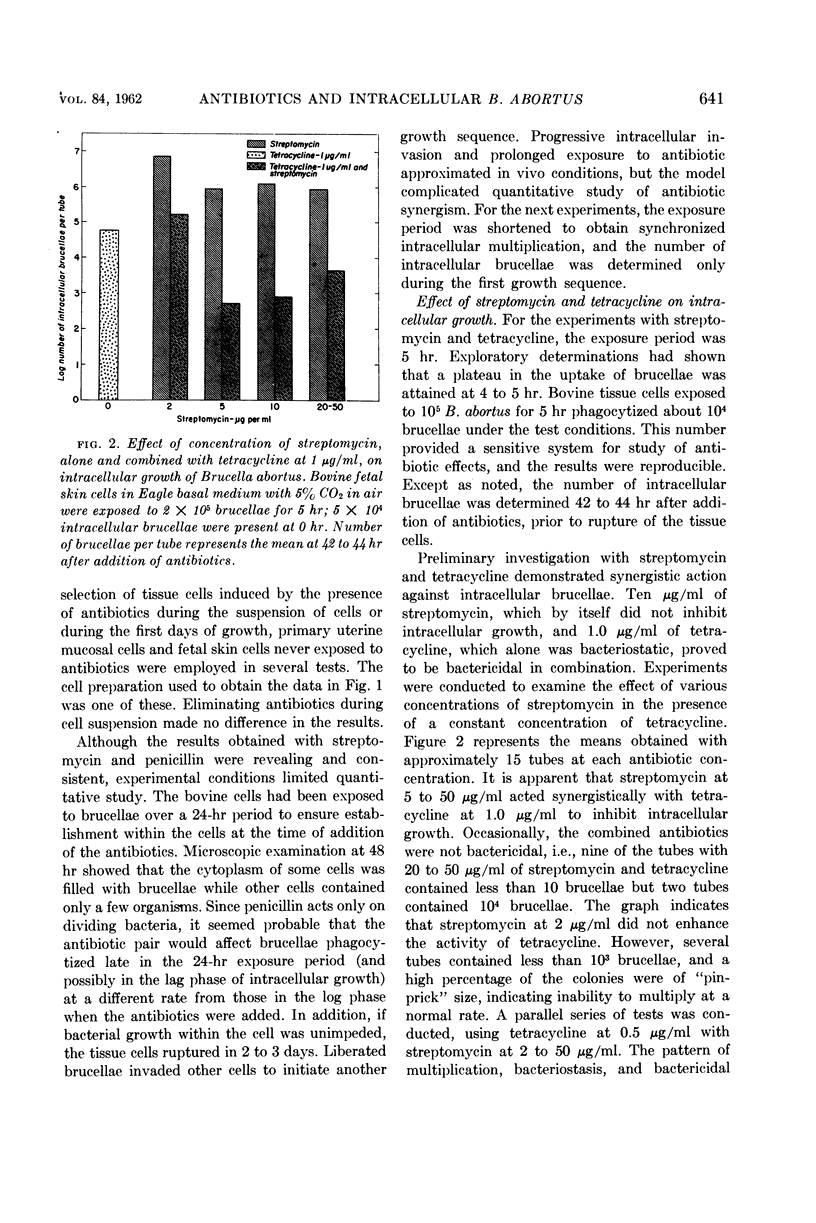
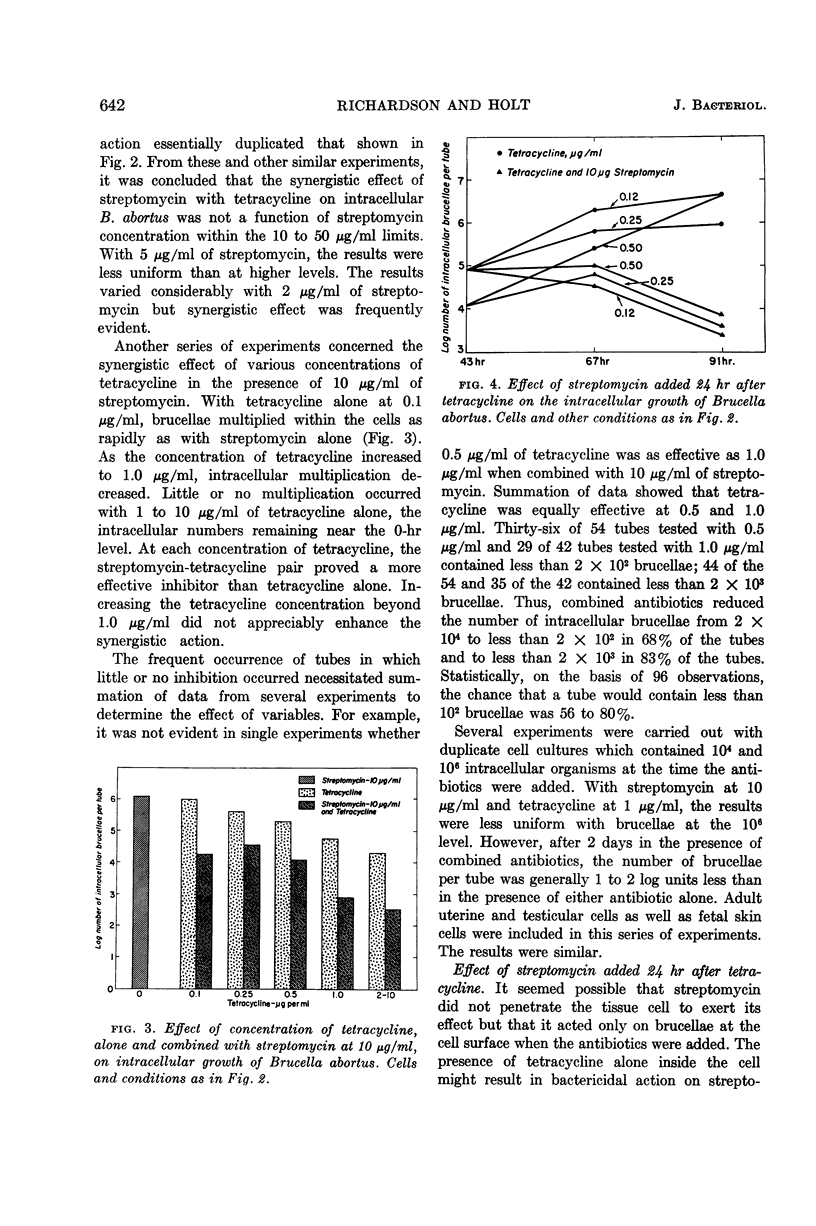
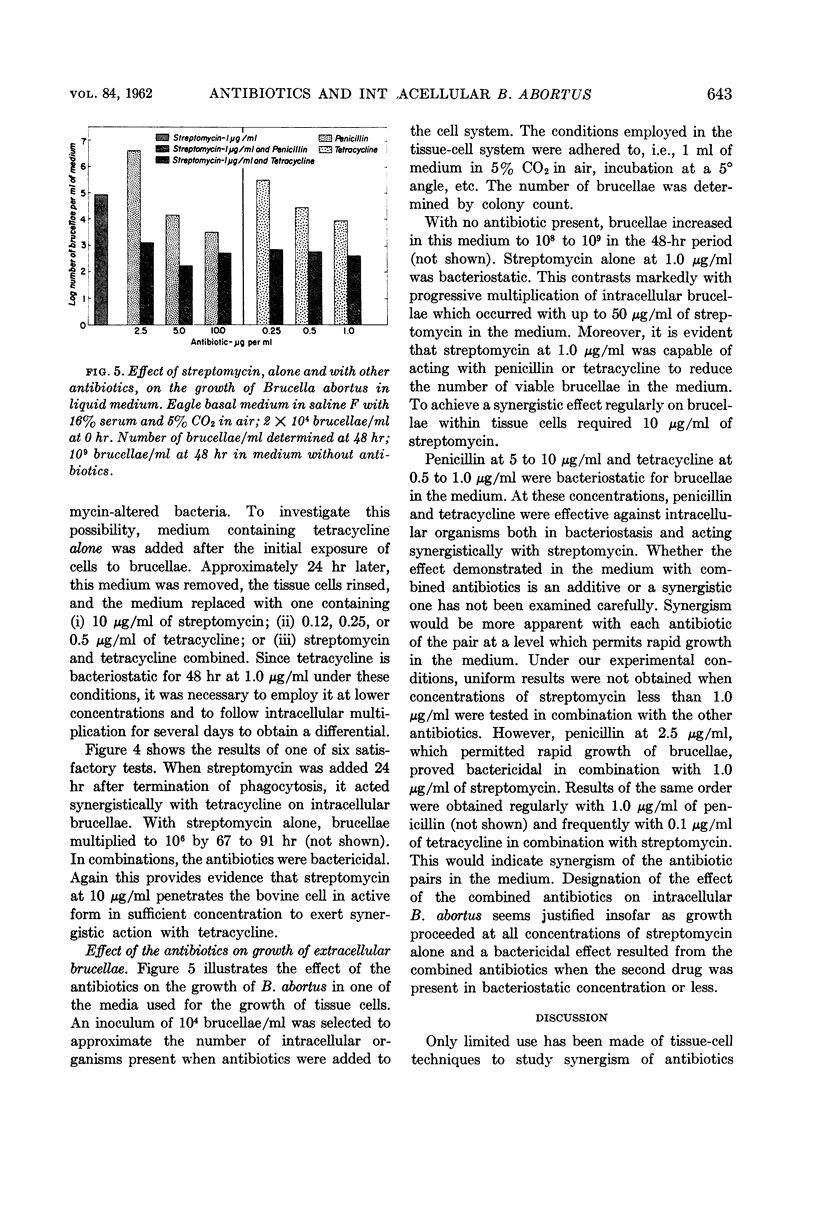
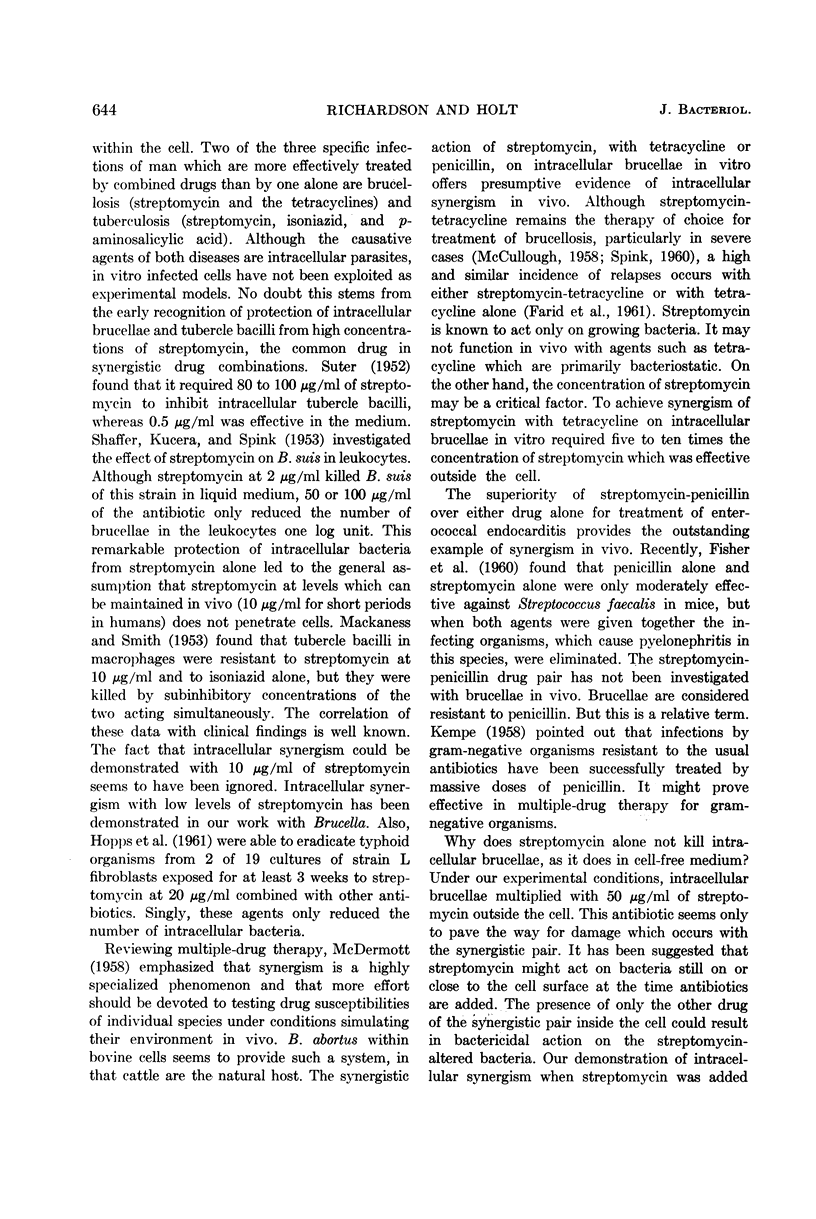

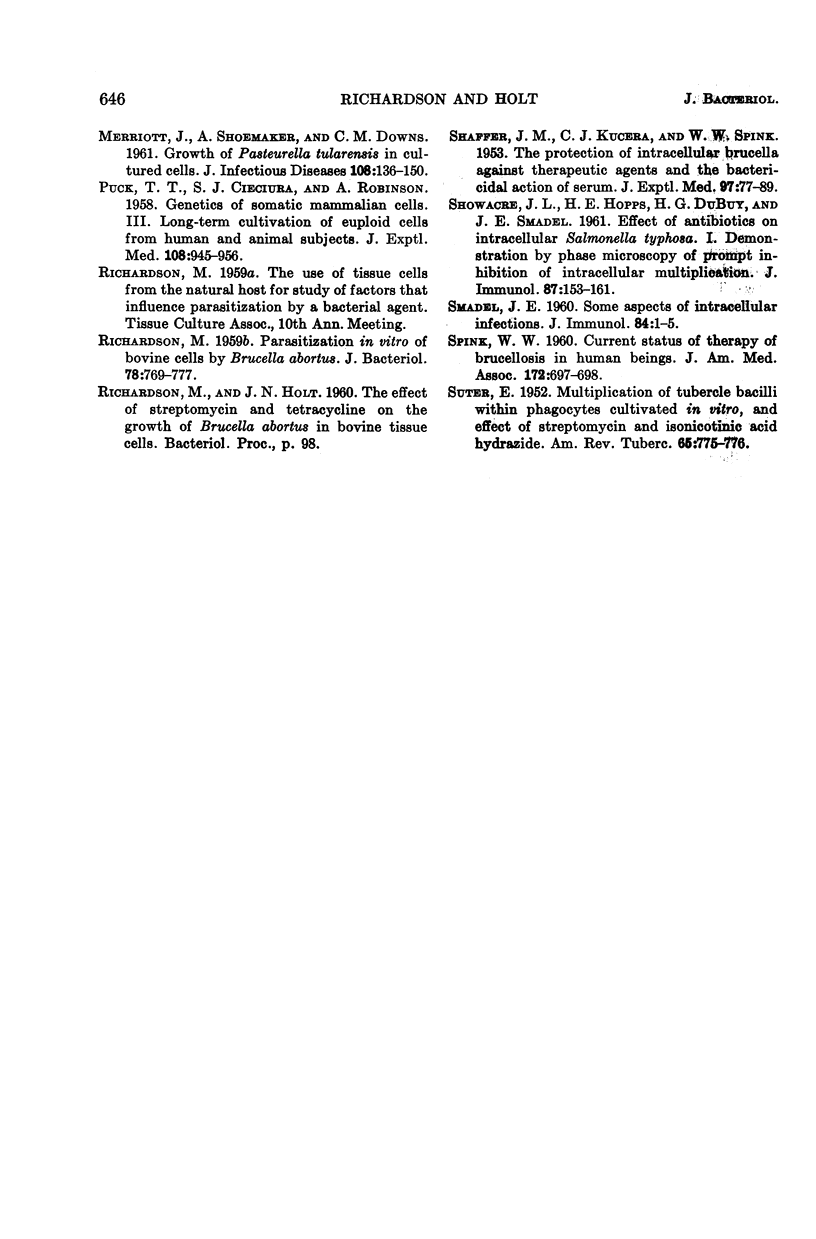
Selected References
These references are in PubMed. This may not be the complete list of references from this article.
- ANAND N., DAVIS B. D. Damage by streptomycin to the cell membrane of Escherichia coli. Nature. 1960 Jan 2;185:22–23. doi: 10.1038/185022a0. [DOI] [PubMed] [Google Scholar]
- EAGLE H. The binding of penicillin in relation to its cytotoxic action. III. The binding of penicillin by mammalian cells in tissue culture (HeLa and L strains). J Exp Med. 1954 Jul 1;100(1):117–124. doi: 10.1084/jem.100.1.117. [DOI] [PMC free article] [PubMed] [Google Scholar]
- FARID Z., MIALE A., Jr, OMAR M. S., VAN PEENEN P. F. Antibiotic treatment of acute brucellosis caused by Brucella melitensis. J Trop Med Hyg. 1961 Jul;64:157–163. [PubMed] [Google Scholar]
- FREEMAN B. A., VANA L. R. Host-parasite relationships in brucellosis. I. Infection of normal guinea pig macrophages in tissue culture. J Infect Dis. 1958 May-Jun;102(3):258–267. doi: 10.1093/infdis/102.3.258. [DOI] [PubMed] [Google Scholar]
- GERBER D. F., WATKINS H. M. Growth of shigellae in monolayer tissue cultures. J Bacteriol. 1961 Dec;82:815–822. doi: 10.1128/jb.82.6.815-822.1961. [DOI] [PMC free article] [PubMed] [Google Scholar]
- HOPPS H. E., SMADEL J. E., BERNHEIM B. C., DANAUSKAS J. X., JACKSON E. B. Effect of antibiotics on intracellular Salmonella typhosa. II. Elimination of infection by prolonged treatment. J Immunol. 1961 Aug;87:162–174. [PubMed] [Google Scholar]
- JENKIN C., BENACERRAF B. In vitro studies on the interaction between mouse peritoneal macrophages and strains of Salmonella and Escherichia coli. J Exp Med. 1960 Aug 1;112:403–417. doi: 10.1084/jem.112.2.403. [DOI] [PMC free article] [PubMed] [Google Scholar]
- KEMPE C. H. Pediatric use of antibacterial agents. J Pediatr. 1958 Jul;53(1):19–36. doi: 10.1016/s0022-3476(58)80196-1. [DOI] [PubMed] [Google Scholar]
- MACKANESS G. B., SMITH N. The bactericidal action of isoniazid, streptomycin and terramycin on extracellular and intracellular tubercle bacilli. Am Rev Tuberc. 1953 Mar;67(3):322–340. doi: 10.1164/art.1953.67.3.322. [DOI] [PubMed] [Google Scholar]
- MACKANESS G. B. The action of drugs on intracellular tubercle bacilli. J Pathol Bacteriol. 1952 Jul;64(3):429–446. doi: 10.1002/path.1700640302. [DOI] [PubMed] [Google Scholar]
- MERRIOTT J., SHOEMAKER A., DOWNS C. M. Growth of Pasteurella tularensis in cultured cells. J Infect Dis. 1961 Mar-Apr;108:136–150. doi: 10.1093/infdis/108.2.136. [DOI] [PubMed] [Google Scholar]
- McCULLOUGH N. B. Human brucellosis, with special reference to the disease in the United States. Ann N Y Acad Sci. 1958 Jun 3;70(3):541–556. doi: 10.1111/j.1749-6632.1958.tb35410.x. [DOI] [PubMed] [Google Scholar]
- PUCK T. T., CIECIURA S. J., ROBINSON A. Genetics of somatic mammalian cells. III. Long-term cultivation of euploid cells from human and animal subjects. J Exp Med. 1958 Dec 1;108(6):945–956. doi: 10.1084/jem.108.6.945. [DOI] [PMC free article] [PubMed] [Google Scholar]
- Richardson M. PARASITIZATION IN VITRO OF BOVINE CELLS BY BRUCELLA ABORTUS. J Bacteriol. 1959 Dec;78(6):769–777. doi: 10.1128/jb.78.6.769-777.1959. [DOI] [PMC free article] [PubMed] [Google Scholar]
- SMADEL J. E. Some aspects of intracellular infections. J Immunol. 1960 Jan;84:1–5. [PubMed] [Google Scholar]
- SPINK W. W. Current status of therapy of brucellosis in human beings. J Am Med Assoc. 1960 Feb 13;172:697–698. doi: 10.1001/jama.1960.63020070004016. [DOI] [PubMed] [Google Scholar]
- SUTER E. Multiplication of tubercle bacilli within phagocytes cultivated in vitro, and effect of streptomycin and isonicotinic acid hydrazide. Am Rev Tuberc. 1952 Jun;65(6):775–776. doi: 10.1164/art.1952.65.6.775. [DOI] [PubMed] [Google Scholar]


